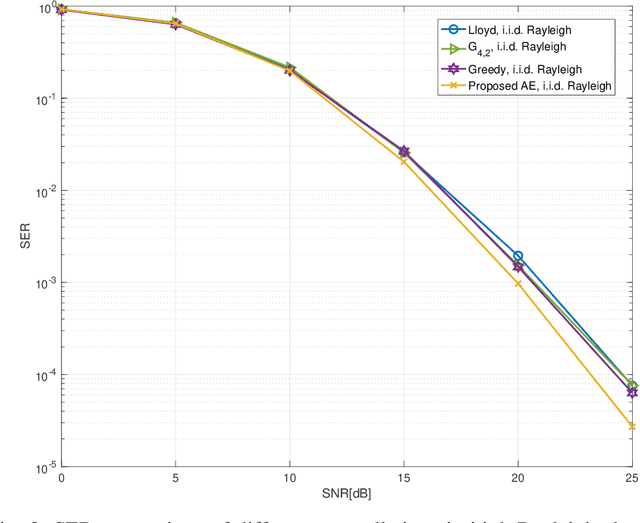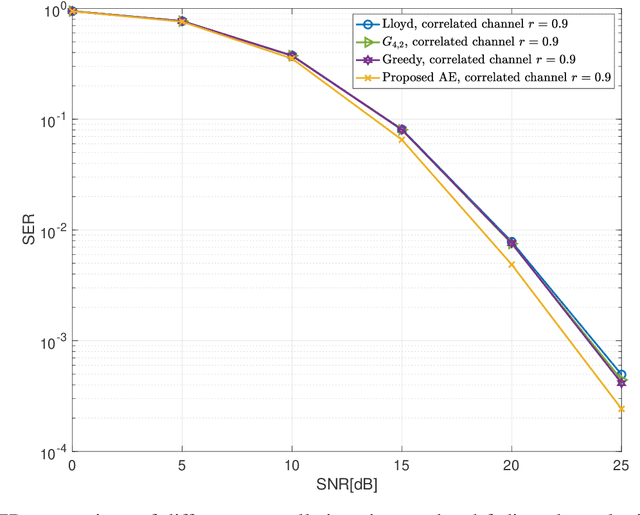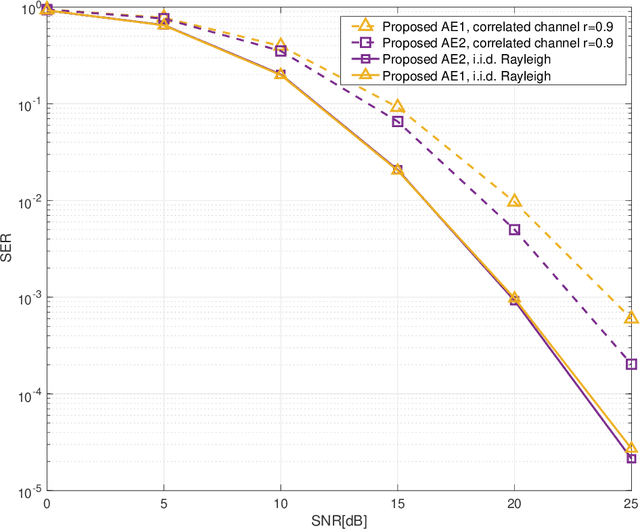Didier Le Ruyet
Affine Filter Bank Modulation: A New Waveform for High Mobility Communications
May 06, 2025Abstract:We propose a new waveform suitable for integrated sensing and communications (ISAC) systems facing doubly-dispersive (DD) channel conditions, as typically encountered in high mobility scenarios. Dubbed Affine Filter Bank Modulation (AFBM), this novel waveform is designed based on a filter-bank structure, known for its ability to suppress out-of-band emissions (OOBE), while integrating a discrete affine Fourier transform (DAFT) precoding stage which yields low peak-to-average power ratio (PAPR) and robustness to DD distortion, as well as other features desirable for ISAC. Analytical and simulation results demonstrate that AFBM maintains quasi-orthogonality similar to that of affine frequency division multiplexing (AFDM) in DD channels, while achieving PAPR levels 3 dB lower, in addition to OOBE as low as -100 dB when implemented with PHYDYAS prototype filters.
Grassmannian Constellation Design for Noncoherent MIMO Systems Using Autoencoders
Sep 01, 2021



Abstract:In this letter, we propose an autoencoder (AE) for designing Grassmannian constellations in noncoherent (NC) multiple-input multiple-output (MIMO) systems. To guarantee the properties of Grassmannian constellations, the proposed AE constructs the transmitted symbols following an unitary space-time modulation. It penalizes the difference between input and output symbols in terms of cross entropy during the training, which is regarded as a generic optimization method. The constellations learned by the proposed AE have substantial symbol error rate (SER) performance gains compared to the non-Grassmannian constellations and conventionally constructed Grassmannian constellations in high SNR regime. The resulting Grassmannian constellation of the proposed AE achieves higher diversity than the non-Grassmannian constellation in i.i.d. Rayleigh channels. Moreover, the proposed approach can be adaptive to different channel statistics by training with corresponding channel realizations.
Sparse Signal Subspace Decomposition Based on Adaptive Over-complete Dictionary
Oct 27, 2016



Abstract:This paper proposes a subspace decomposition method based on an over-complete dictionary in sparse representation, called "Sparse Signal Subspace Decomposition" (or 3SD) method. This method makes use of a novel criterion based on the occurrence frequency of atoms of the dictionary over the data set. This criterion, well adapted to subspace-decomposition over a dependent basis set, adequately re ects the intrinsic characteristic of regularity of the signal. The 3SD method combines variance, sparsity and component frequency criteria into an unified framework. It takes benefits from using an over-complete dictionary which preserves details and from subspace decomposition which rejects strong noise. The 3SD method is very simple with a linear retrieval operation. It does not require any prior knowledge on distributions or parameters. When applied to image denoising, it demonstrates high performances both at preserving fine details and suppressing strong noise.
 Add to Chrome
Add to Chrome Add to Firefox
Add to Firefox Add to Edge
Add to Edge